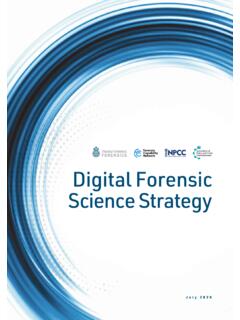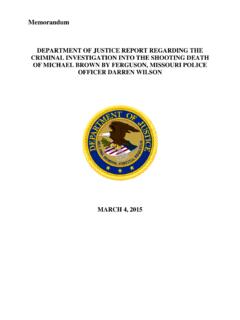Transcription of 3.4 Crime Scene Documentation and Forensic Photography
1 47 Crime Scene Investigationt Briefly record initial observations of the answers to who, what, where, when, and how questions. This is not an appropriate time for a detailed description of the Access the Scene for personnel, precautions, or equipment that will be Notify superior officers or other agencies as Crime Scene Documentation and Forensic PhotographyOnce the Crime Scene has been evaluated by the preliminary Scene survey, the Crime Scene s condition must be recorded or documented. This is perhaps the single most important task of the Crime Scene investigator. Given that Crime scenes are transi-tory and begin to change the instant after they are created, it is essential to have a permanent record of the Scene as it was before processing.
2 The purpose of Crime Scene Documentation is to permanently record the condition of the Crime Scene and its physical evidence. It is the most time-consuming activity at the Scene and requires the investigator to stay organized and systematic. Problem-solving skills, innova-tion, and originality will also be needed. The four major tasks of Documentation are (1) note taking, (2) videography, (3) Photography , and (4) sketching. All four are neces-sary and none is an adequate substitute for another; for example, notes are not sub-stitutes for Photography and video is not a substitute for sketching. Each tool must be applied when and where needed to give as complete a record as Digital Imaging and PhotographyOne of the most striking changes in Crime Scene Documentation in the past 20 years is the advent of digital imaging, which has replaced traditional film cameras in all but a very few instances.
3 (See Sidebar for more about the history of Forensic Photography .) Digital image technology provides the Crime Scene investigator with powerful tools for capturing, analyzing, and storing the record of the Crime Scene and its physical evidence (Figure ). These digital image tools complement the tra-ditional video and still Photography used in Crime Scene Documentation . The advan-tages of digital images include instant access to the images, easy integration into existing electronic technologies, and no need for the often expensive film processing SIDEBAR HISTORICAL NOTE: THE BEGINNINGS OF Forensic PHOTOGRAPHYF orensic Photography came of age during the killings in London attributed to Jack the Ripper (1888).
4 Photographs of victims and the Crime scenes became famous and revealed the brutality of the crimes. Europe was the site of much of the pioneering work in Forensic Photography , including the early use of what are now called mug shots in Switzerland in the mid-1850s. The growing importance of Forensic Photography was instrumental in the founding of the Lausanne Institute of police Science in Lausanne, Switzerland, in 1902. This institute remains a hub of Forensic science education throughout Europe and the 4712/16/13 11:14 AM48 Forensic Science: An Introduction to Scientific and Investigative Techniquesequipment and darkrooms. Some disadvantages of the use of digital image technol-ogy are centered on issues of court admissibility due to the ease of image manipula-tion using programs such as Photoshop.
5 This problem has become less of an issue as software now generally provides logs and records of any edits that are done to the original. Thus, any changes to a digital image are recorded with that image and are easily retrievable. Figure Capturing, analyzing, and storing the record of the Crime 4812/16/13 11:14 AM49 Crime Scene InvestigationThe purpose of still Photography Documentation of the Crime Scene is to provide a true and accurate pictorial record of the Crime Scene and physical evidence present. As a result of this Documentation , Photography is used to record the initial condition of the Scene . It provides investigators and others with a record that can be analyzed or examined subsequent to the Scene investigation, and it serves as a permanent record for any legal concerns.
6 Photography of a Crime Scene is normally done immediately fol-lowing videography of the Scene or after the preliminary Scene survey. The number of photographs required varies from Scene to Scene and too many is always better than too few. Table summarizes some general guidelines for Crime Scene Photography . Every photograph that is taken at the Crime Scene must be recorded in a photo log. The log should include the time taken, camera settings used, an indication of distance to subject, the type of photograph taken, and a brief description of the Forensic MappingAnother Forensic application to come out of the digital revolution is the use of imag-ing technology and mapping technology (GPS) to compile a Crime Scene map that can, in some cases, be rendered in three dimensions.
7 There are several incarnations Figure (cont.) Capturing, analyzing, and storing the record of the Crime 4912/16/13 11:14 AM50 Forensic Science: An Introduction to Scientific and Investigative Techniquesof Crime Scene mapping hardware, but most include a method of electronic distance determination (also called electronic data collection, or EDC), height and slope mea-surements, mapping capability, and the ability to locate points in three dimensions (including elevation information). The data are downloaded to a program that then reconstructs the data and generates a three-dimensional map of the Scene . This equipment is similar to that used by surveyors, and the practice of recording scenes this way is sometimes referred to as Forensic NotesEffective notes as part of a Crime Scene investigation serve as a written record of all of the Crime Scene activities.
8 The notes are taken as the activities are done so they are not subject to memory loss at a later time. A general guideline for note taking is to consider the W s (who, what, when, where, and why), in addition to the following:t Notification information Note the date and time, method of notification, and information Arrival information Note the means of transportation, date and time, per-sonnel present at the Scene , and any notifications to be Scene description Note the weather, location type and condition, major structures, identification of transient and conditional evidence, containers holding evidence of recent activities (ashtrays, trash cans, etc.)
9 , clothing, fur-niture, and any weapons Victim description In most jurisdictions, the body should never be moved or disturbed until the medical examiner has given approval. Once given per-mission, then note victim position, wounds, clothing, jewelry, or identifica-tion (its presence or absence).t Crime Scene team Note assignments to team members, walk-through infor-mation, beginning and ending times, and evidence handling for Photographing Crime ScenesType of PhotographGuidelines for PhotographingOverall photographsExteriors Surroundings, buildings and major structures, roads or paths of travel into or away from Scene , street signs or survey markers, mailboxes or address numbers; take aerial photographs when possible; photograph before 10 or after 2 if Use the four compass points or room corners to orient photographs; overlap views; take photographs of doors leading into and out of the structure.
10 Use a tripod in low light situations for increased depth of photographsFollow a step-wise progression of views; use various lenses or change the focal length of the lenses to achieve a focused view of the individual items of evidence within the original view of the Crime Scene ; add flash lighting to enhance details or patterned photographsUse Documentation placards; use flash Photography (flash must be detached from the camera); use proper side lighting effects; fill in with a flash when harsh shadows are present; take photographs with and without photographsRecord in log; use camera settings that achieve good depth of focus; include no extraneous objects such as team members, equipment, feet, or hands; change point of view; be aware of reflective surfaces; when in doubt, photograph it!













